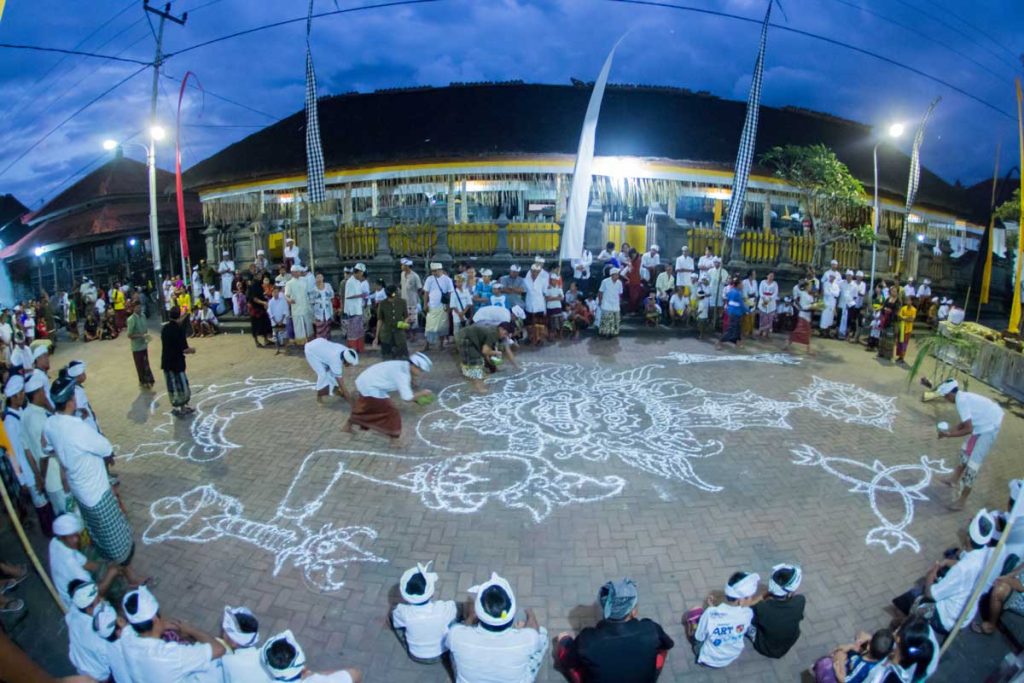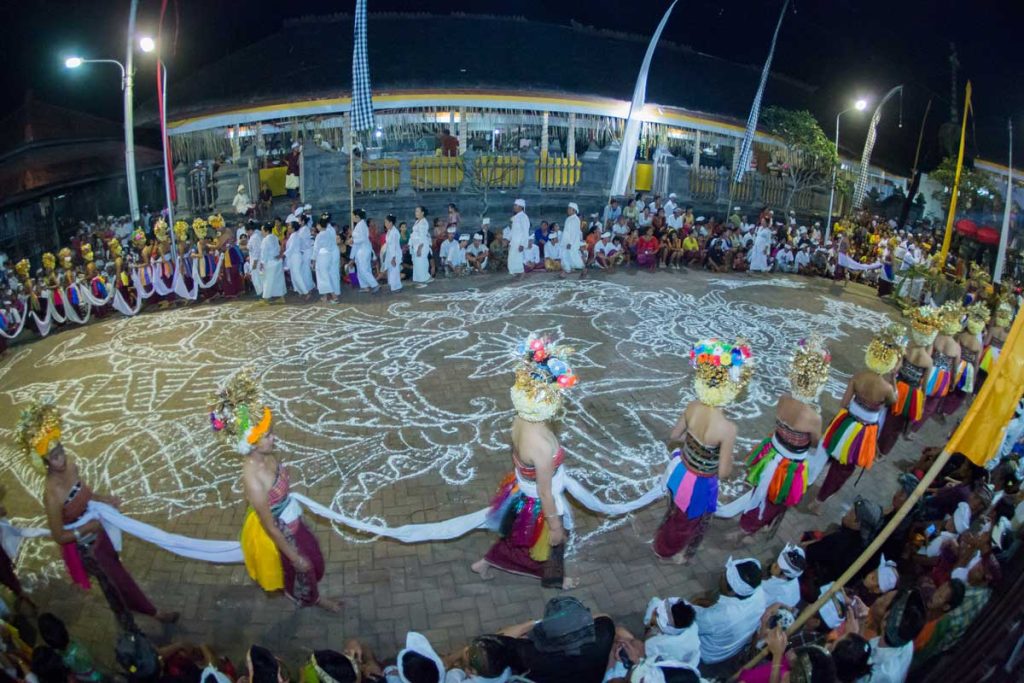The Balinese are known for putting up extraordinary shows during their temple festivals. Most popular are the processions and dances that take place on these occasions. But there are other aspects that are no less extraordinary. One of them is the roughly 13-metre long drawing on the ground which is ceremoniously made in Bugbug every year on the occasion of the temple festival of the bale agung, the meeting quarters of the village family heads.

Magical drawings are important elements of the ritual paraphernalia of Bali. They are used to ward off negative influences. Called rajah, there are hundreds of them. Each has it specific ritualistic function, and each formulates in its own way an aspect of the complex Indo-Balinese cosmology. Most drawings are small. But in the case of Bugbug, a village in Karangasem, the rajah drawn for the temple festival is a huge one, representing Yama Raja, the ruling lord of the Balinese hell. It is as long as the bale agung, the long, central village meeting hall. Its function is to cleanse the village territory and people just before the actual temple festival — locally called the aci manggung — so that the village may retain its prosperity.
The yamaraja drawing is not just made by any villager. The drawer, who must already have some knowledge of drawing, is selected by the customary village head on the basis of melik, “signs”, attributed to him (it is always a man) that indicate his aptitude to connect with the intangible niskala world. Once selected, he is inducted for the purpose in a small pewintenan ceremony. The ingredient he uses to draw on the ground is chalk, which is also ritually purified. He works accompanied by a helper. As for the Yama character he draws, it follows strict iconographic patterns, similar to that found for the god Yama in the puppet show theater. He has raksasa (giant) features: large eyes, big nose and mouth; dressed in kingly attire, he sports a head-dress of the type reserved to royalty. Rather fat, represented with a big tummy, he appears standing, his feet arched in a warrior defensive posture. Above his head one sees a disc-looking symbol of the world, sign of his power over life and death. He carries several of the weapons that are the attributes of the gods of the rose of the winds, to which is added a cup of burning incense (dupa). Hence, says a local informant, “the positive energy issuing from sacred incense, added to the power of the compass gods, turns Yama into a protector, locally worshipped as Ratu Gede Sakti. Yama thus preserves the village from the forces threatening the crops—like pest, drought etc”.
The yama raja drawing is not permanent. It is made to operate with its exorcist function only at the time of the temple festival: he cleans the place so that the visiting ancestral deities, called Batara Tirta – or “Water Gods” may come down for a visit among their “incarnated dew”, or damuh. Like most agriculture related festivals, the Bugbug festival follows the Balinese solar-lunar Saka calendar, that began on the year 74th of the Gregorian calendar. It takes place just before the full moon of the Kasa month, on one of the last three days prior to the full moon – the one corresponding to the propitious beteng day of the three-day week. The ceremonies that follow are complex, and among the most beautiful of Bali.
For our purpose let us say that, prior to the descent of the gods, the latter’s effigies (pratima) and other symbols are taken to the sea in a long melasti procession, complete with the village gamelan music, at around 1pm or 2pm. When at the sea, they are bathed and thus cleansed, in order to be able to become the ancestral gods’ repositories. The drawing of Yama is made during the 2 to 3 hours it takes to go to the beach, to cleanse the effigies and other symbols, and to go back to the village, which is quite a long walk away. It begins with a small exorcism, then the drawer makes a thin sketch of the Yama character, with its characteristic iconography. But the contours are still barely visible. A mesh of chalk is then applied, using a branch of the sacred dadab tree as a “pen”. Only then do the features of Yamaraja clearly stand out.

When the procession approaches the village from the beach, the young unmarried girls from the community prepare themselves. All dressed in the same beautiful light-brown outfit, and the same hair-dress with flowers, they put themselves in a line and gird themselves into shawls in such a way as to be linked to one another. The link may not be broken, lest it be a nefarious omen. They then advance dancing, accompanied by the gamelan, in the slow swinging movements of the local rejang. They walk dancing, three times and counter-clock-wise, around the yamaraja image of the lord of hell, which is now ipso facto turned into a beneficial force. When it is all over, the village is cleansed. People throw themselves on the image, to get as much chalk as they can collect, to be used later as concoctions, ointments and other similar uses.
The Batara Tirta, or ancestral gods – called significantly water gods — may now be invited to come down. The Bugbug people are ready to welcome them, with yet other beautiful dances and ceremonies. But that is another story.
These photographs, and photographs of other rare and magnificent ceremonies, are published in Ida Bagus Putra Adnyana’s new photography book titled ‘Ancient Spirit of Bali – the great richness of religious traditions’ / Instagram: @ib_putra_adnyana









